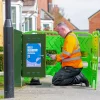Openreach Trial G.fast Broadband DLM Tweak to Improve Speeds UPDATE

Openreach has notified UK ISPs of an upcoming trial on their hybrid-fibre G.fast based “ultrafast broadband” (100Mbps+) products (including SOGFAST), which looks as if it will attempt to improve line performance by establishing the “most effective” Dynamic Line Management (DLM) thresholds.
Just to recap. Before the FTTP rollout took centre stage in 2018/19, Openreach initially attempted to squeeze more out of their existing copper lines by deploying G.fast technology from their local PCP street cabinets, which were fed by fibre (copper was only used for the final run into homes). The service ended up being rolled out to 2.83 million UK premises before it was effectively shelved in 2019 (here), so that the operator could focus on full fibre.
The service, much like ADSL2+ and FTTC (VDSL2) before it, harnessed a DLM system to automatically control the speed and stability of copper based broadband lines. In practice, this means that line speeds may go up or down depending upon how stable / error-prone (interference etc.) the system thinks your connection is (i.e. it monitors and learns – dynamically adjusting for changes on the line).
Advertisement
Openreach’s public briefing on the new trial merely says that it “aims to establish the most effective DLM Thresholds for the best Customer experience” (here) and, at the time of writing, we don’t have much information on the detail of what it will actually be adjusting.
However, tentative feedback from our sources suggest that it may introduce less sensitive thresholds for Mean Time Between Errors (MTBE), which roughly reflects how many errors a line can get away with per day before the system takes action. Openreach thus appears to be seeking to establish which DLM thresholds produce the lowest propensity to call and lowest fault rates.
In theory, such tweaks could aid line stability and performance, although this would vary and we’ve asked Openreach if they can provide a bit more detail to help us understand the adjustments they’re planning. On the other hand, most ISPs that did originally offer G.fast packages (160Mbps and 330Mbps) have now stopped selling it due to a combination of factors – primarily overbuild by FTTP, as well as issues with G.fast modem/router availability and cost.
Nevertheless a small portion of consumers do remain stuck in a location where G.fast is the best they can currently get. In that sense, it’s good to see that Openreach are continuing to find ways of improving a technology that is ultimately NOT going to be sticking around for a long time to come.
Advertisement
UPDATE 15th June 2023 @ 8:55am
We’ve been able to gather a bit more information about the trial. Much as stated above, it’s about fine-tuning the MTBE parameters, with the aim of unlocking greater speeds for some of their G.fast lines.
The parameters used today are largely based on learnings gained from Openreach’s existing Fibre-to-the-Cabinet (FTTC / VDSL2) network, however, G.fast uses additional technologies for tackling interference that allows lines to adapt to changes in real time. Put another way, a less sensitive configuration should allow greater speed without compromises to stability.
At least, that’s the theory and the trial will test it. Only if this proves to be successful will the changes be rolled out across the operator’s entire G.fast network.
Advertisement
Mark is a professional technology writer, IT consultant and computer engineer from Dorset (England), he also founded ISPreview in 1999 and enjoys analysing the latest telecoms and broadband developments. Find me on X (Twitter), Mastodon, Facebook, BlueSky, Threads.net and Linkedin.
« Hyperoptic’s Anti-Mid Contract Price Hikes Campaign Backed by Labour
Zzoomm FTTP Broadband Goes Live in Bewdley, Worcestershire »






















































Meanwhile ARCHERS COURT exchange with over 6,000 customers has no sign on the plans for FTTP at all!
FTTC for most at around 25-38mbps unless very close to the exchange which is in area away from housing. Lots of cross-talk preventing higher speeds due to numbers on each cabinet.
OR don’t care as long they get your money!
Tweaking the DLM on copper and rolling out FTTP are kinda different workflows with one not being impacted by the other?
There is nothing exceptional about Archer’s Court exchange. It was an early ECI build with some later Huawei. The premises passed per cabinet range from sub-200 to just over 600. All the cabinets above 220 premises passed received FTTC.
The cabinets on Archer’s Court are parented by Dover exchange, the ECI OLT BAACDK and the Huawei OLT BAAEHZ. The ECI OLT was ready for service in October 2011, the Huawei November of 2014.
Premises on this exchange have Openreach FTTP right now, with Netomnia building out also. You may not have a date or have been covered yet but the exchange area absolutely has full fibre from the Dover exchange.
Will allow Openreach to better compete with rivals Virgin, alt-nets in areas where Openreach doesn’t have FTTP buildout (yet).
100-300 (with 10+ upload) certainly fast enough for majority of users, especially when linked up to best class Wifi router in the property.
Wish they could stretch a few more metres distance with G Fast..
Haha, you wish but these will never gonna to happen under useless OR.
> Wish they could stretch a few more metres distance with G Fast..
It’s a laws-of-physics thing. To keep G.Fast independent from ADSL and VDSL, they are using higher frequencies which don’t overlap – but those frequencies are attenuated much more severely.
If they did VDSL profile 35b, speeds could be much higher. But that would require vectoring, and also having to turn off exchange-based (LLU) ADSL altogether.
@NE555 Shame we never got Profile 35b,a missed opportunity & with the 17b Profile the current 80Mb limit should have been around 100Mb..
“If they did VDSL profile 35b, speeds could be much higher. But that would require vectoring, and also having to turn off exchange-based (LLU) ADSL altogether”
VDSL2 Profile 35b could have (and does in some countries) coexist with ADSL.
They simply lower the VDSL2 power on the frequencies that are shared with ADSL.
That’s exactly what they do now with VDSL2 Profile 17a and they would have used the exact same method for VDSL2 35b.
Profile 35b would have coexisted with both ADSL and VDSL2 Profile 17a.
It would not have been compatible with the ECI FTTC estate. That can’t be upgraded to profile 35b and does not support system level vectoring.
In short, if they picked profile 35b instead of G.Fast then they would have had to either;
1. replace all the ECI DSLAM’s with Huawei, then upgrade Huawei DSLAM’S to do 35b or
2. Skip ECI areas completely
The Huawei estate can do Node level vectoring. That’s vectoring across multiple DSLAMs, which would be necessary anywhere a PCP has more than 1 DSLAM.
ADSL would not have been affected in any way.
Very strange, out of reach is trying to get us to use FTTP and yet try to improve their hybrid system. As far as I know, you have to live pretty close to the cabinet to get anything from G.fast and mucking around with it may make it even more unreliable than it is.
You have to closer to the G.fast within 50m to get maximum 330/50! Can get more than that but useless OR don’t want to go faster than 330/50. Many G.fast in UK are only getting less 160/30. Pretty useless unfit for purpose G.fast as a waste of time.
If many are only getting 160 what’s the point in going higher than 330?
You are incoherent here, Phil. I know you’re upset that you don’t have FTTP or a plan for it yet but what are you trying to say about G.fast? Yes, we all know it’s poop and Openreach do too, which is why they’re overbuilding it with full fibre as quickly as possible.
I have Gfast on a near perfect pair.
I get 294/48.5 measured yesterday.
It is fine for home and I could get OR or CF FTTP which I will move onto.
GFast works fine close to the PCP with decent copper.
Our street is fed from both ends – the middle can’t get Gfast.
I’d have taken G.fast if it were available, we have a customer using it as a backup connection where the pod is right outside their door and it’s been synced for about two years without any problems. The focus is rightly on FTTP now though, so hopefully this isn’t taken any resources above what would usually be required to maintain the service.
Bit like Microsoft providing updates for windows 10 whilst trying to push end users onto windows 11, when many can’t upgrade anyway.
I am lucky to get 5mb and yet at the end of my road they have over 100mb. Maybe they need to fix the broken systems first
That’s useless OR for ya! Openreach are unfit for purpose in UK as we know it.
This is why OR don’t want you to have 100Mb service under profile 35b cos they bunch of useless OR.
That makes absolutely no sense. You aren’t getting 35b because Openreach are investing in FTTP rather than G.fast cards and pods. You know, as you want them to?
A_Builder says:
June 14, 2023 at 2:49 pm
I have Gfast on a near perfect pair.
I get 294/48.5 measured yesterday.
Really??? G.fast isn’t on many ISP now.
“Really??? G.fast isn’t on many ISP now.”
BT, EE, Sky and Talktalk all sell G.Fast, along with many smaller providers.
Why is it so unbelievable that someone has G.Fast just because some providers have stopped selling it?
I usually get 305/47 on my g.fasy connection. Only time had issue was when fault on another line for another customer, which was causing interference in the cabinet.
Been told it be around Dec 2026 before we get full FTTP
A family member had G.Fast but at the end of the contract all companies wanted over double the price and it was an absolute battle getting switch back to FTTC, switches to other companies were rejected and the current ISP would only switch in return for a new 18 month expensive contract (this lock in or double contract was never mentioned during questing before getting G.Fast). In the end had to get the CEO office involved to switch to FTTC with current ISP with new contract but matching rivals deal. I already have Cityfibre but sadly family don’t have the option yet.
I’m a happy g-fast customer and have enjoyed the service for a few years now. Bit disappointed that it probably means I’ll be pushed further and further down the list whne it comes to FTTP. Reason I say this is that 300 meg g-fast is priced around the £50 mark (with BT) whereas 500 meg FTTP is around the £35 currently. Even though gfast is great, I’d love to have the option of FTTP.
G.fast are overpriced and rip off by OR.